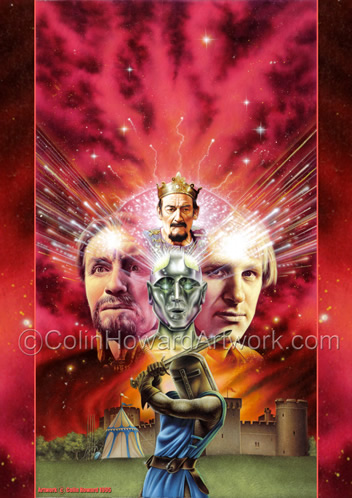We now arrive in England in 1215 at the castle of Sir Ranulf Fitzwilliam. The 5th Doctor, Tegan and Turlough (a first appearance in history for our exiled alien public schoolboy) arrive in the middle of a jousting match between Hugh Fitzwilliam and Sir Gilles Estram (have you worked it out yet). Sir Gilles is at the castle accompanying King John but it is soon revealed that Sir Gilles is (gasp!) the Master and that King John is, in fact, a shape-changing android called Kamelion. The Master is in 1215 to prevent King John from signing the Magna Carta. The Doctor kidnaps Kamelion thwarting his plans. The end.
That is basically it. There is a fair amount of toing and froing from banquet hall to dungeon with some sword fighting and horse riding thrown in for good measure, but basically this two episode story is a vehicle to introduce Kamelion.
Kamelion is, for me, one of the more imaginative creations of the JNT era. I know that the plans he had for the robot never came to fruition through tragic circumstances but the general concept of a shape changing android on board the TARDIS could have made for some brilliant stories. One of my favourite Virgin Missing Adventures is The Crystal Bucephalus by Craig Hinton (the one with Kamelion on the cover) which plays with the character’s potential. I’m aware that, eventually, he would probably have to break down every other episode, just as K9 did before him, as his abilities may have been too easy a get out clause for writers, but as one of Doctor Who’s ‘might-have-beens’ I have always found him fascinating.
Unfortunately, Kamelion is introduced in one of the slightest television stories ever. I have complained quite a few times in these reviews that the one shot comic strips from the likes of DWM are often very unsatisfying in that very little happens in them. The King’s Demons feels like the televisual equivalent of one of those one shots. The short length is obviously a contributary factor, but I don’t feel the same about other two episode stories such as Black Orchid or The Awakening. It’s the fact that the Master’s scheme is so low key that the viewer never feels there is very much at stake. The Doctor himself doesn’t seem overly concerned and Tegan and Turlough do very little plot wise.
Ainley’s performance as the Master also leaves a little to be desired. This story, I reckon, shows the first glimmerings of the twirly-moustache villain we see through the rest of the 80s. I didn’t feel this was evident in Time-Flight (and to be fair, I don’t remember it being particularly prominent in Planet of Fire) but it’s probably the script that’s to blame as it doesn’t give Ainley much to work with, especially as the Master’s scheme is so odd.
The medieval setting, however, is very well realised. There is a lovely (I presume) glass plate shot at the beginning showing the expanse of the Great Hall, and the whole production is designed beautifully. At times it does feel a little clichéd what with wolfhounds and dwarf jesters, but the sheer number of extras in authentic-looking costumes makes this feel far more of a story than it actually is. Possibly the director, Tony Virgo (who delivers an informative if slightly dull commentary for Part One), realised how slim the script was and decided to try and distract the audience with nice things to look at.
I’m not entirely sure how historically accurate everything on display is and, at times, it feels like the production design is based more on familiar tropes from 1930s/1940s films such as Robin Hood or A Connecticut Yankee in King Arthur’s Court, but as a short hand for the viewer it does the job. Aside from the wolfhounds and jester, we have guards, swords, crossbows, horses, the castle, jousting, tents, iron maidens, a king’s champion, lutes, mention of Saracens, lots of moustaches and beards, Sir Gilles slapping the Doctor with a gauntlet to challenge him to a duel, banquets full of food and lots of animal skins and furs.
The guest characters dialogue is suitably medieval but doesn’t reach the florid heights of The Crusade’s Shakespearean verbosity.
There are, technically, no real historical characters in this story as King John is really a robot, but we do have allusions to a real historical event, even if it doesn’t actually occur within the timeframe of the story.
We do have a little history lesson from the Doctor when he explains to Tegan about the Magna Carta, debunking the idea that King John was forced to sign it.
I think I’ll always have a soft spot for The King’s Demons simply for the introduction of Kamelion. As a Master story it is forgettable (although his TARDIS being disguised as an iron maiden is fun – especially the scene where he is forced into it with some blood-curdling screams). It’s a shame it became a lacklustre end to Season 20 when the planned Dalek story fell through (although seeing what eventually became of that (Resurrection of the Daleks) maybe it’s not such a bad thing) but it’s not the worst story of this era.
